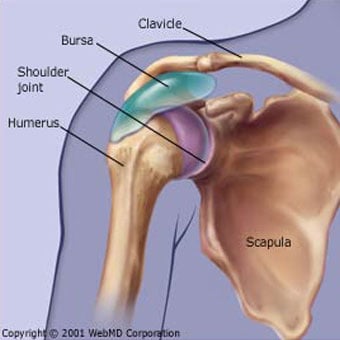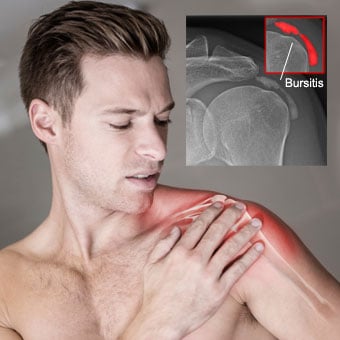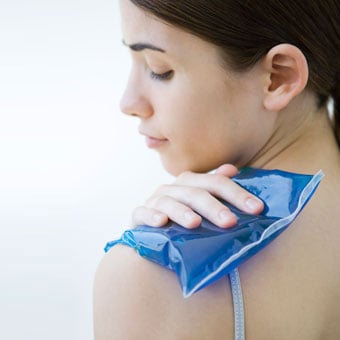Shoulder Bursitis
- What Is It?
- Causes
- Risk Factors
- Symptoms
- Treatment
- Home Remedies
- Physical Therapy
- Prevention
- Doctor Specialists

What is shoulder bursitis?
A bursa is a tiny fluid-filled sac that functions as a gliding surface to reduce friction between tissues of the body. The plural of bursa is bursae. There are 160 bursae in the body. The major bursae are located adjacent to the tendons near the large joints, such as the shoulders, elbows, hips, and knees.
Bursitis is inflammation of a bursa. Injury or inflammation of a bursa around the shoulder joint causes shoulder bursitis.
What causes shoulder bursitis?
A bursa can become inflamed from injury, infection (rare in the shoulder), or an underlying rheumatic condition. Examples include infection of the bursa in front of the knee from a knee scraping on asphalt (septic prepatellar bursitis), inflammation of the elbow bursa from gout crystals (gouty olecranon bursitis), or injury as subtle as lifting a bag of groceries into the car, which could inflame the shoulder bursa and lead to shoulder bursitis.
What are risk factors for shoulder bursitis?
Injury or strain to the shoulder joint causes shoulder bursitis. Activities that are common risk factors for shoulder bursitis include throwing a ball, lifting objects overhead, and trauma from a fall onto the shoulder.

What are shoulder bursitis symptoms and signs? How is shoulder bursitis diagnosed?
Bursitis is typically identified by localized pain or swelling, tenderness, and pain with motion of the tissues in the affected area.
- Shoulder bursitis is often accompanied by tendinitis of tendons adjacent to the affected bursa in the shoulder.
- Shoulder bursitis causes focal tenderness of the inflamed tissues.
- Shoulder bursitis can also cause a "pinching" pain when the elbow is moved away from the body, referred to as an "impingement" sign.
X-ray testing can sometimes detect calcifications in the bursa when bursitis has been chronic or recurrent. MRI scanning (magnetic resonance imaging) can also define bursitis.

What are treatments for shoulder bursitis?
Sometimes shoulder bursitis requires aspiration of the bursa fluid. This procedure involves the removal of the fluid with a needle and syringe under sterile conditions and can be performed in the doctor's office. Often the fluid is sent to the laboratory for further analysis.
- Noninfectious shoulder bursitis can also be treated with an injection of cortisone medication into the swollen bursa. This is typically done at the same time as the aspiration procedure.
- Physical therapy can be used to aid the recovery from bursitis, especially when it is accompanied by a frozen shoulder.
Infectious (septic) bursitis, which is uncommon in the shoulder, requires even further evaluation and aggressive treatment. The bursal fluid can be examined in the laboratory to identify the microbes causing the infection.
- Septic bursitis requires antibiotic therapy, sometimes intravenously.
- Repeated aspiration of the inflamed fluid may be required.
- Surgical drainage and removal of the infected bursa sac (bursectomy) may also be necessary. Generally, the adjacent joint functions normally after the surgical wound heal.
Are there home remedies for shoulder bursitis?
Bursitis is initially treated with
What is the prognosis for shoulder bursitis?
The outlook for shoulder bursitis is generally excellent for a full recovery with shoulder bursitis. If the bursitis is accompanied by scarring around the shoulder joint (adhesive capsulitis or "frozen shoulder"), it can require long-term physical therapy.
Is it possible to prevent shoulder bursitis?
By avoiding overuse of the shoulder by excessive straining the shoulder and gradual exercise training, shoulder bursitis can be prevented.
What health care specialties treat shoulder bursitis?
Specialists that treat shoulder bursitis include general medicine physicians, including general practitioners, family medicine doctors, and internists, as well as orthopedic surgeons, rheumatologists, and sports medicine specialists. Often physical therapists and rehabilitation physicians are involved in the care of shoulder bursitis.


